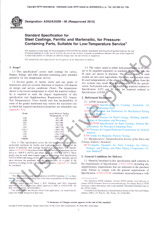We need your consent to use the individual data so that you can see information about your interests, among other things. Click "OK" to give your consent.
ASTM D7406-20
Standard Test Method for Time-Dependent Compressive Deformation Under Constant Pressure for Geosynthetic Drainage Products
Translate name
STANDARD published on 1.1.2020
The information about the standard:
Designation standards: ASTM D7406-20
Publication date standards: 1.1.2020
SKU: NS-982282
The number of pages: 4
Approximate weight : 12 g (0.03 lbs)
Country: American technical standard
Category: Technical standards ASTM
The category - similar standards:
Annotation of standard text ASTM D7406-20 :
Keywords:
compressive deformation, geosynthetic,, ICS Number Code 59.080.70 (Geotextiles)
Additional information
| Significance and Use | ||||||||||||||
|
5.1 The performance characteristics of a drainage geosynthetic are directly related to the integrity under compressive loading. If the product is sensitive to compressive deformation, its flow capacity could be greatly reduced or even shut off completely. 5.2 The deformation sensitivity of a candidate geosynthetic can be tested at field-simulated normal stress and potential tangential stresses. 5.3 This test method does not evaluate the effect of deformation of a geotextile filter or adjacent membrane. 5.4 Compression deformation, as it relates to reduction in flow capacity of a geosynthetic drainage product, is manufacturer and product specific. For example, a 10 % reduction in original thickness of a geonet made by Manufacturer A does not necessarily equal the same reduction in flow capacity as a 10 % reduction in thickness of the same or another type of geonet made by Manufacturer B. 5.5 This deformation data has merit directly to the end user, because it can be easily interpreted to result in a reduction factor for compressive deformation.1.1 This test method is used to determine the unconfined compressive deformation (consolidation) characteristics of drainage geotextiles, geocomposites, geonets, or any other geosynthetic associated with drainage at a constant temperature, when subjected to a constant compressive stress. 1.2 This test method is intended for use as an unconfined compressive performance deformation test only. For a detailed procedure on how to establish an index test, see EN ISO 25619-1. For performance tests, the specimen shall be subjected to the site-specific liquid, the site-specific stress (normal and potentially a tangential stress on the upper and parallel loading platen), or both. Note 1: Results achieved from unconfined compressive
performance deformation testing may differ from testing performed
under confined conditions.
1.3 Because of the changing nature of the geosynthetic industry and the wide variety of products already available, this particular test method may have to be slightly modified for unconfined compression deformation testing of some products. 1.4 The values given in SI units are to be considered as the standard. The values given in parentheses are for information only. 1.5 This standard does not purport to address all of the safety concerns, if any, associated with its use. It is the responsibility of the user of this standard to establish appropriate safety, health, and environmental practices and determine the applicability of regulatory limitations prior to use. 1.6 This international standard was developed in accordance with internationally recognized principles on standardization established in the Decision on Principles for the Development of International Standards, Guides and Recommendations issued by the World Trade Organization Technical Barriers to Trade (TBT) Committee. |
||||||||||||||
| 2. Referenced Documents | ||||||||||||||
|
We recommend:
Technical standards updating
Do you want to make sure you use only the valid technical standards?
We can offer you a solution which will provide you a monthly overview concerning the updating of standards which you use.
Would you like to know more? Look at this page.




 Cookies
Cookies
